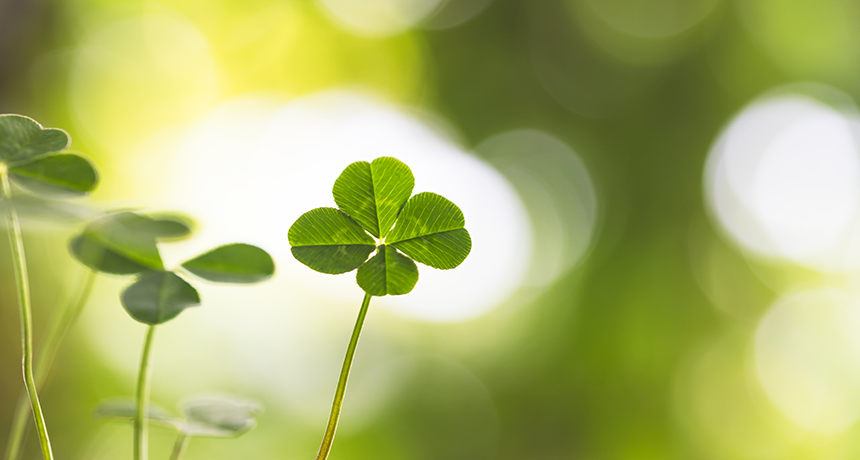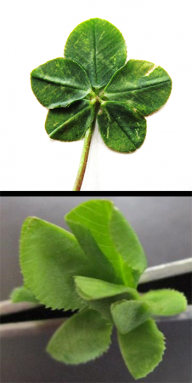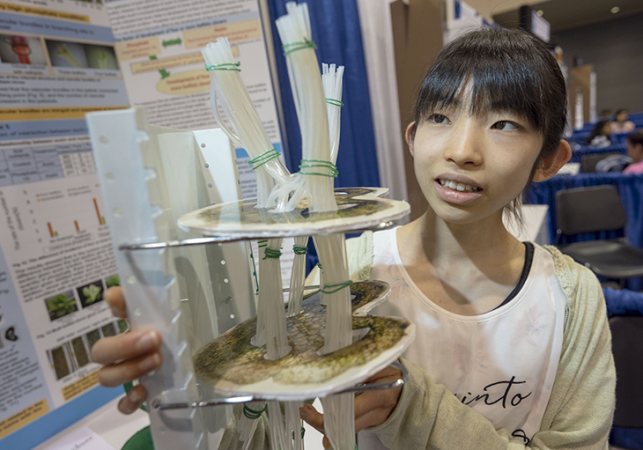Need a little luck? Here’s how to grow your own
Teen researcher from Japan uses plant hormone to boost leaf counts in clover

Minori Mori from Tsukuba, Japan, used a plant hormone and extra fertilizer to boost the share of four-leaf clovers she could produce. This became her research recipe for becoming a finalist at the 2019 Intel International Science and Engineering Fair.
imacoconut/iStock/Getty Images Plus
By Sid Perkins
PHOENIX, Ariz. — According to superstition, a four-leaf clover brings good luck. Wouldn’t it be nice to be able to grow your own whenever you wanted? A 17-year-old researcher from Japan has found a way to do just that.
The shamrock, maybe the most familiar type of clover, belongs to two species in a genus called Trifolium. That name, which comes from Latin, means three leaves. And it well describes this plant. Only one shamrock in every few thousand has more than three leaves, notes Minori Mori, a 12th grader at Meikei High School in Tsukuba, Japan.
Some companies sell clover seeds that will grow into plants that are more likely to produce four leaves. But even in plants grown from these seeds, four-leafed ones remain rare. Minori wondered if she could somehow boost the odds of getting four-leafed clovers.
The teen showcased her success here, this week, at the Intel International Science and Engineering Fair, or ISEF. This competition was created by Society for Science & the Public. (The Society also publishes Science News for Students.) The 2019 event, which was sponsored by Intel, brought together more than 1,800 finalists from 80 countries.
Four-leaf clovers are most likely to show up in well-fertilized soil, Minori notes. She also knew that a hormone called auxin plays an important role in plant development. She decided to test how auxin and phosphates (an ingredient in common fertilizers), affected the chance of getting four-leafed clovers.
She ordered some of those special white clover seeds (Trifolium repens) and then grew them under a variety of conditions.

Agricultural research has shown that farmers who grow clover should use about 10 kilograms (22 pounds) of phosphate for each 40,000 square meters (10 acres) of farmland, says Minori. But she would be growing her seeds in plastic bins that measured only about 58.5 centimeters (23 inches) long and 17.5 centimeters (7 inches wide). She calculated that would translate to 58.3 grams (about 2 ounces) of phosphate per bin.
She added that amount to some of her bins. Some of these made up her control group, meaning they were grown under normal conditions. The teen added double the normal amount of phosphate to other bins. The seeds in some bins with each dose of fertilizer were watered with a 0.7 percent solution of auxin throughout the 10-day experiment. The others got plain water.
In her control group, 372 of the seeds matured into clover plants. Only four (about 1.6 percent) had four leaves. Two more had five leaves. In bins getting double the normal amount of phosphate but no auxin, 444 of the seeds sprouted into plants. And of these, 14 (or about 3.2 percent) had four leaves. So the extra phosphate doubled the share of shamrocks with more than three leaves.
If terms of four-leaf clovers, adding auxin didn’t seem to help much, Minori found. Only 1.2 percent of the seeds grew into four-leafed clovers if they were fertilized with a normal amount of phosphate and received auxin. That’s a slightly smaller share than in plants that got no auxin. About 3.3 percent of the plants that received both extra phosphate and auxin (304 in all) developed four leaves. That’s almost the same fraction as those receiving double phosphate but no auxin.
Where auxin did make a difference was in encouraging plants to grow more than four leaves. In bins fertilized with both auxin and a double dose of phosphate, a total of 5.6 percent grew more than four leaves. These included 13 with five leaves, two with six leaves, and one each with seven and eight leaves.
“Four-leaf clovers are considered lucky in Japan,” says Minori. “But clover plants with more leaves than that should be considered extra lucky!”








